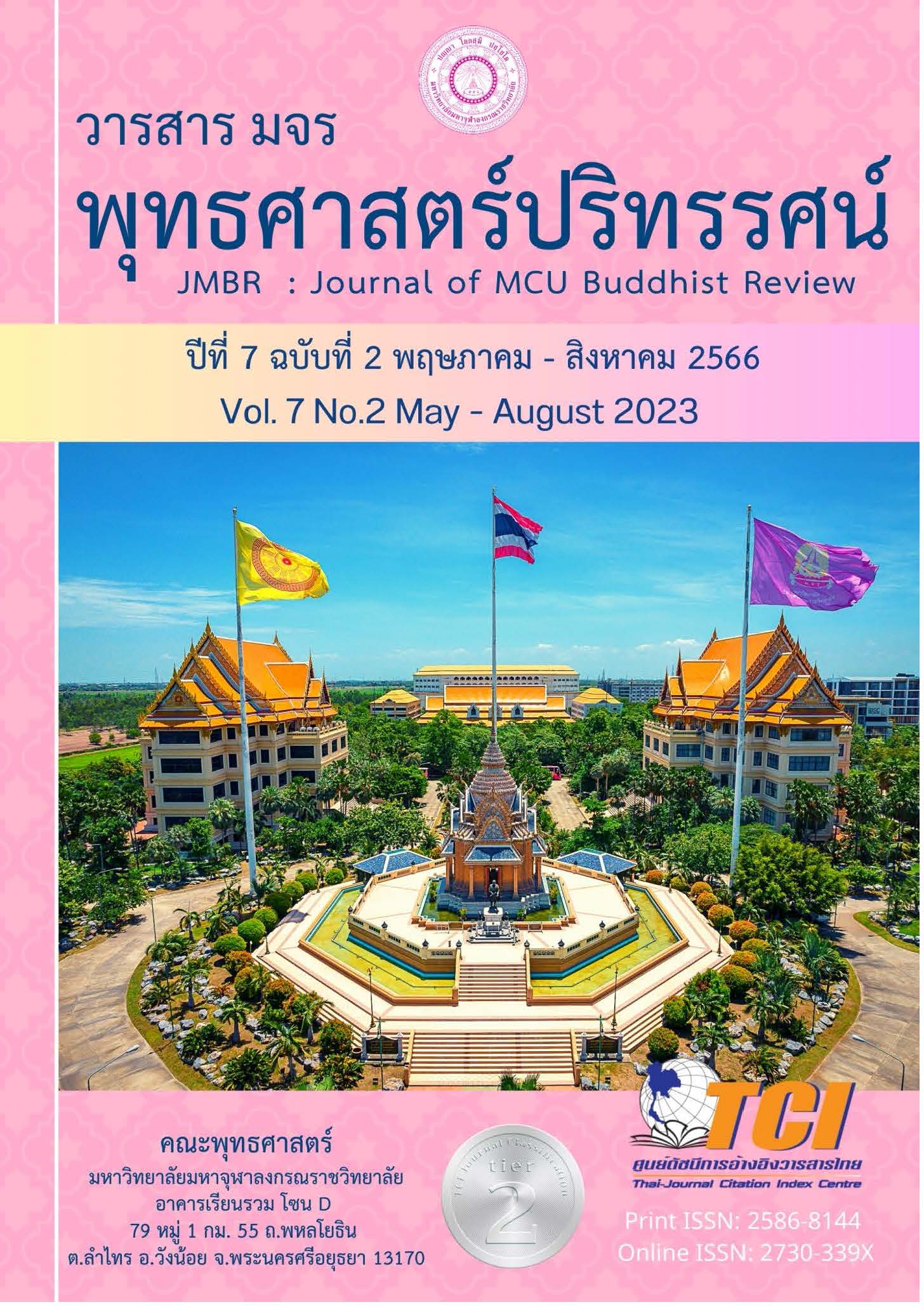ทูตกาวยะ: ลำนำรักสันสกฤต
Main Article Content
บทคัดย่อ
บทความวิจัยมีวัตถุประสงค์ 1) เพื่อศึกษาเรื่องทูตกาวยะ 2) เพื่อศึกษาองค์ประกอบและคุณลักษณะ
ของทูตกาวยะ และ3) เพื่อศึกษาทูตกาวยะที่ปรากฏอยู่หรือเป็นที่รู้จักกันในปัจจุบัน เป็นการวิจัยเชิงเอกสาร วิเคราะห์ และนำเสนอผลวิจัยเชิงพรรณนา
ผลการวิจัยพบว่า ทูตกาวยะนับว่าเป็นหนึ่งในสาขาอันสำคัญของวรรณคดีสันสกฤต บทกวีประเภททูตกาวยะนี้จะใช้ทูตเป็นผู้ส่งสาร บทกวีนี้มีปรากฏอยู่เป็นอันมากและมีชื่อเรียกอีกว่า สันเทศกาวยะ หรือบทกวีประเภทส่งสาร บทกวีที่เก่าแก่ที่สุดคือ ฆะฏะกัรประกาวยะ บทกวีที่มีชื่อเสียง มากที่สุดคือ เมฆทูตของกาลิทาส ทูตกาวยะประกอบด้วยองค์ประกอบ 2 ส่วน ได้แก่ ส่วนที่ 1 จะอธิบายราย ละเอียดเกี่ยวกับทูตผู้ส่งสารที่จะส่งข้อความไปสู่จุดหมายปลายทาง ส่วนที่ 2 จะอธิบาย รายละเอียดเกี่ยวกับ บ้านของนางเอก และความรักของเธอในการแยกจากคนรัก มีคุณลักษณะที่สำคัญคือ การใช้สิ่งที่ไม่มีชีวิต เช่น เมฆ ลม เป็นต้น หรือสิ่งที่มีชีวิต เช่น ผึ้ง นก เป็นต้น ในท้ายที่สุดก็ใช้สิ่งซึ่งไม่สามารถเคลื่อนที่ได้กล่าว คือนามธรรม เช่นความจงรักภักดี หรือจิตใจเป็นต้นเป็นทูต ทูตกาวยะที่ปรากฏอยู่หรือเป็นที่รู้จักกัน ในปัจจุบันมีจำนวน 48 บท ได้แก่ 1. อินทุทูต 2. อุทธวทูต 3. อุทธวสันเทศ 4. กีรทูต 5. โกกิลสันเทศ 6. โกกิลสันเทศ 7. โกกิลสันเทศ 8. จโกรสันเทศ 9. จันทรทูต 10. จันทรทูต 11. จันทรทูต 12. จาตกสันเทศ 13. เจโตทูต 14. ไชนะ เมฆทูต 15. ตุลสีทูต 16. เนมิทูต 17. ปทูงกทูต 18. ปวนทูต 19. ปวนทูต 20. ปานถทูต 21. ปิกทูต 22. ภักติทูต 23. ภฤงคสันเทศ 24. ภรมรทูต 25. มโนทูต 26. มโนทูต 27. มโนทูต 28. มโนทูติกา-กาวยะ 29. มโนทูต 30. มยูรสันเทศ 31. เมฆทูต 32. เมฆทูต 33. เมฆทูต สมัสยาเลข 34. รถางคทูต 35. วิปรสันเทศ 36. ศีลทูต 37. ศุกสันเทศ 38. ศุกสันเทศ 39. ศุกสันเทศ 40. สิทธทูต 41. สุภคสันเทศ 42. หํสทูต 43. หํสสันเทศ 44. หํสสันเทศ 45. หํสสันเทศ 46. หํสทูต 47. หฤทยทูต 48. หํสทูต
Article Details

อนุญาตภายใต้เงื่อนไข Creative Commons Attribution-NonCommercial-NoDerivatives 4.0 International License.
- บทความที่ได้รับการตีพิมพ์เป็นลิขสิทธิ์ของวารสาร มจร พุทธศาสตร์ปริทรรศน์
- ข้อความใดๆ ที่ปรากฎในบทความที่ได้รับการตีพิมพ์ในวารสาร ถือเป็นความรับผิดชอบของผู้เขียนบทความ และข้อคิดเห็นนั้นไม่ถือว่าเป็นทัศนะและความรับผิดชอบของกองบรรณาธิการวารสาร มจร พุทธศาสตร์ปริทรรศน์
เอกสารอ้างอิง
กุสุมา รักษมณี. (2549). การวิเคราะห์วรรณคดีไทยตามทฤษฎีวรรณคดีสันสกฤต. กรุงเทพฯ: ภาควิชาภาษาตะวันออกคณะโบราณคดี มหาวิทยาลัยศิลปากร.
จำลอง สารพัดนึก. (2546). ประวัติวรรณคดีสันสกฤต 1. กรุงเทพฯ: ภาควิชาภาษาไทยและภาษาตะวันออก คณะมนุษยศาสตร์ มหาวิทยาลัยรามคำแหง.
จิรายุ นพวงศ์ และหม่อมหลวง. (2535). จิรายุนิพนธ์. คณะอักษรศาสตร์ จุฬาลงกรณ์มหาวิทยาลัย.
ปาจรีย์ ณ นคร. (2550). ความรักในทฤษฎีวรรณคดีสันสกฤต. วิทยานิพนธ์อักษรศาสตร์มหาบัณฑิต คณะอักษรศาสตร์: จุฬาลงกรณ์มหาวิทยาลัย.
นาวิน วรรณเวช. (2551). วิโลมจิตระในรามกฤษณวิโลมกาวยะ. วิทยานิพนธ์อักษรศาสตร์มหาบัณฑิต คณะอักษรศาสตร์: จุฬาลงกรณ์มหาวิทยาลัย.
พระมหาจตุภูมิ แสนคำ. (2563). สวภาโวกติ: การพรรณนาธรรมชาติในเมฆทูตของกาลิทาส. วิทยานิพนธ์ปริญญามหาบัณฑิต ภาควิชาภาษาตะวันออก: มหาวิทยาลัยศิลปากร.
หลวงบวรบรรณรักษ์ (นิยม รักไทย). (2552). สํสกฤษ-ไท-อังกฤษ อภิธาน. พิมพ์ครั้งที่ 4. กรุงเทพฯ: แสงดาว.
อัจฉราภรณ์ ธาตุวิสัย. (2556). การศึกษาวิเคราะห์คีตโควินทกาวยะ. วิทยานิพนธ์ปริญญามหาบัณฑิต สาขาวิชาภาษาสันสกฤต: มหาวิทยาลัยศิลปากร.
Chakravarti, S. (1996). Patralekha: Romance of Letters in Indian Art and Literature. Calcutta: Benoytosh Centenary Committee.
Chandran, Mini. A Sreenath V.S.. (2021). An Introduction to Indian Aesthetics: History, Theory, and Theoreticians. Bloomsbury Publishing.
Datta, A. (1994). Encyclopaedia of Indian Literature volume II. Delhi: Sahitya Akademi.
Divyasena, S.. (2015). Duta - The messenger. Retrieved 15 April 2023 from http://www. ijmdrr.com/admin/downloads/2609201514.pdf
Greene, R. (2012). The Princeton Encyclopedia of Poetry and Poetics. United Kingdom: Princeton University Press.
Law, Narendra Nath. (1927). Indian Historical Quarterly Vol. 3. Delhi: Caxton Publication.
Nasa. (2000). Tutu Poetry - Messenger poems in Indian Literature. Retrieved 15 April 2023 from https://nasa2000.livejournal.com/52279.html
Sanskrit College (Calcutta, India). (1963). Calcutta Sanskrit College Research Series, no. 23. Calcutta: Sanskrit College.
Veṅkaṭanātha. (2016). The Flight of Love: A Messenger Poem of Medieval South India by Veṅkaṭanātha. Translated with Commentary by Steven P. Hopkins. Oxford University Press.
Williams, M. (1899). A Sanskrit-English Dictionary. Oxford: The Clarendon Press.


